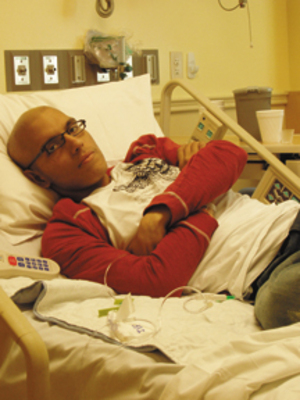Some 19-year-old college students get a tan or a tattoo over the summer. Cesar Jimenez got cancer.
The Union City native, whose family has a long history in Hoboken, couldn’t go back for his sophomore year at Montclair State University. Instead of navigating the campus, he’s now navigating the halls of Hackensack University Medical Center and hoping that his second bone marrow transplant will save his life.
A year ago, Jimenez was spending his summer break at the gym, in fine shape until he started feeling tired and worn down.
“I was finding it hard to do daily activities,” Jimenez said last week from his hospital bed. “I was running for three years and my sister asked me to go for a jog.”
By the end of the jog, he was in more breathing pain than his asthmatic sister.
Then he found bumps on the back of his neck and he went to see the doctor. On Aug. 13, Jimenez was diagnosed with leukemia, or cancer of the body’s blood-forming tissue, like bone marrow.
Since then, Jimenez has braved chemotherapy, an unsuccessful bone marrow transplant, and more chemotherapy. Now he awaits a doctor’s decision regarding another transplant.
Easier to be a donor
Michelle Poliskin is a bone marrow donor recruiter at DKMS Americas, the world’s largest marrow donor center.
She said many people have misconceptions about being a bone marrow donor, but that it only takes a swab of the mouth and short registration form to be entered into the list of donors. The mouth swab gives the organization a sample of your DNA. From there, they can see if you are a match for someone in need.
The transplant process is has become easier than people think it is, too. Doctors only need the stem cells from the blood and are able to draw them out. In 80 percent of cases, blood can be drawn from the donor’s left arm through a tube. Stem cells are secured by the donation specialists, and the blood is returned promptly to the right arm.
“You can sit in a chair, watch TV, and save someone’s life,” Poliskin said.
The other 20 percent of donations are made through an older procedure that includes a long needle that is inserted into the hip bone. Even this, Poliskin said, only leaves the donor feeling sore for a day or two.
Little sister is first donor
Jimenez’ best match for a bone marrow transplant was his 5-year-old sister Chanelle.
“He wants to live. He wants to get through this.” – Luisana Jimenez
________
“There’s a lot of things that can go wrong with transplants,” Poliskin said.
His doctors are now deciding whether it is best to try Chanelle as a donor again or try one of two matches found for Jimenez.
But the chances of a successful recovery diminish during the second transplant, and Jimenez said the chances are almost nil after that. Nonetheless, he holds out hope.
Donor’s needed
Jimenez’ older sister Luisana organized a donor drive recently in Hoboken, where her father’s business is. His father owns a small supermarket on the west side of town.
Working with DKMS, Luisana drew almost 200 donors and raised $2,000 for DNA match testing. Poliskin said most drives only enlist 25 people.
Although her brother won’t find his match in this set of donors, another patient might. 3,000 patients are searching for a donor match daily, Poliskin said, but only a couple of thousand donors are available in their database.
Minorities are especially underrepresented on the donor list, she said, and minority patients are harder to find a match for.
“It’s extremely hard to find a match for ethnic minorities,” she said.
A family united
Jimenez said one of the worst side effects of his disease is the way his family is engulfed in it.
“It’s been hard on everybody. That’s one of the problems with leukemia,” he said. “A person who has cancer puts a huge burden on their family.”
“Mom’s always at the hospital,” Luisana said. “My dad needs help at work [running the family business].”
She said she takes over for her mother; then her mom returns to stay the night.
“It’s been hard, but I feel like I’ve gotten closer to him,” Luisana said.
His family is rallying around him, and he is handling the situation as best as he can.
“He makes jokes,” Luisana said. “He’s really optimistic about everything.”
Before the illness, Jimenez said he was timid. “I really didn’t like going out and meeting people,” he said.
But in the times since – in between the chemo and the transplant – he said the world has looked different.
“After this, it didn’t make sense to me anymore,” Jimenez said, “this weird fear I had in my head. I started enjoying my days more.”
“He wants to live. He wants to get through this,” Luisana said.
Check out our continuously updated breaking news and leave a comment at www.hudsonreporter.com.
Timothy J. Carroll may be reached at tcarroll@hudsonreporter.com.
